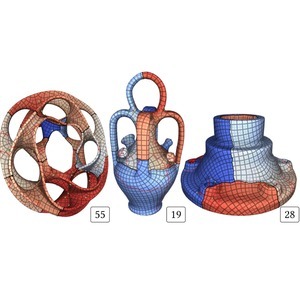
Leyi Zhu
Ph.D. Candidate
Courant Institute of Mathematical Sciences, New York University
I am a Ph.D. candidate at the Courant Institute of Mathematical Sciences, New York University, advised by Daniele Panozzo and Denis Zorin. I received my Bachelor's Degree in Computational Mathematics from the University of Science and Technology of China in 2019.
My research interests include Computer Graphics (Geometric Computing & Physics-based Simulation), Scientific Computing, and Machine Learning.
You can find my CV here.
Selected Publications

Which Cross Fields Can Be Quadrangulated?
ACM Transaction on Graphics (SIGGRAPH), 2022
Advisors: Prof. Denis Zorin, Prof. Daniele Panozzo
- We describe a method for the generation of seamless surface parametrizations with guaranteed local injectivity and full control over holonomy. Previous methods guarantee only one of the two.
- Local injectivity is required to enable these parametrizations’ use in applications such as surface quadrangulation and spline construction.
- Holonomy control is crucial to enable guidance or prescription of the parametrization’s isocurves based on directional information, in particular from cross-fields or feature curves, and more generally to constrain the parametrization topologically.
- We investigate the relation between cross-field topology and seamless parametrization topology.
- Leveraging previous results on locally injective parametrization and combining them with insights on this relation in terms of holonomy, we propose an algorithm that meets these requirements.
- A key component relies on the insight that arbitrary surface cut graphs, as required for global parametrization, can be homeomorphically modified to assume almost any set of turning numbers with respect to a given target cross-field.

Efficient and Robust Discrete Conformal Equivalence with Boundary
ACM Transaction on Graphics (SIGGRAPH Asia), 2021
Advisors: Prof. Denis Zorin, Prof. Daniele Panozzo
- We describe an efficient algorithm to compute a discrete metric with prescribed Gaussian curvature at all interior vertices and prescribed geodesic curvature along the boundary of a mesh.
- The metric is (discretely) conformally equivalent to the input metric.
- Its construction is based on theory developed in [Gu et al. 2018b] and [Springborn 2020], relying on results on hyperbolic ideal Delaunay triangulations.
- Generality is achieved by considering the surface’s intrinsic triangulation as a degree of freedom, with particular attention paid to the proper treatment of surface boundaries.
- While via a double cover approach, the case with boundary can be reduced to the case without boundary naturally, the implied symmetry causes challenges related to stable Delaunay-critical configurations, which we address explicitly.
- We also explore the numerical limits of the approach and derive continuous maps from the discrete metrics.

Simulation and Visualization of Ductile Fracture with the Material Point Method
ACM SIGGRAPH / Eurographics Symposium on Computer Animation (SCA), 2019
Best Paper Award
Advisor: Prof. Joseph Teran
Video
- We present novel techniques for simulating and visualizing ductile fracture with the Material Point Method (MPM).
- We utilize traditional particle-based MPM as well as the Lagrangian energy formulation, using a tetrahedron mesh instead of particle-based estimation for deformation gradient and potential energy.
- Failure and fracture are modeled through elastoplasticity with damage, using a softening model once material deformation exceeds a Rankine or von Mises yield condition.
- After damage, the material’s Lamé coefficients are modified to represent failed material.
- We design visualization techniques to render the material boundary and its intersections with evolving crack surfaces.
- Our approach includes an efficient element-splitting strategy for tetrahedron meshes to represent cracks, utilizing an extrapolation technique based on the MPM simulation.
- For particle-based MPM, we use an initial Delaunay tetrahedralization to connect randomly initialized MPM particles.
- The visualization technique is a post-process, designed to run after the MPM simulation for efficiency.
- We demonstrate our method with challenging simulations of ductile failure, including persistent self-contact scenarios.

Vehicle Re-Id by Deep Feature Fusion Based on Joint Bayesian Criterion
International Conference on Pattern Recognition (ICPR), 2018
Advisor: Prof. Mingtao Pei
- Vehicle re-identification is challenging due to the minimal differences between vehicles of the same model.
- We propose to fuse deep features extracted by two different CNNs for vehicle re-identification.
- CNNs extract discriminative features for classification, and features from different CNNs complement each other by describing different aspects of the input image.
- We introduce a new loss function called the Joint Bayesian loss to fuse the different deep features.
- The Joint Bayesian loss minimizes intra-class variations and maximizes inter-class variations, making it suitable for vehicle re-identification.
- Experiments on a large-scale vehicle dataset demonstrate the effectiveness of our proposed method.
Contact Information:
Email: leyi *AT* nyu.edu
Office: 60 Fifth Ave, Office 520, New York, NY 10011, USA